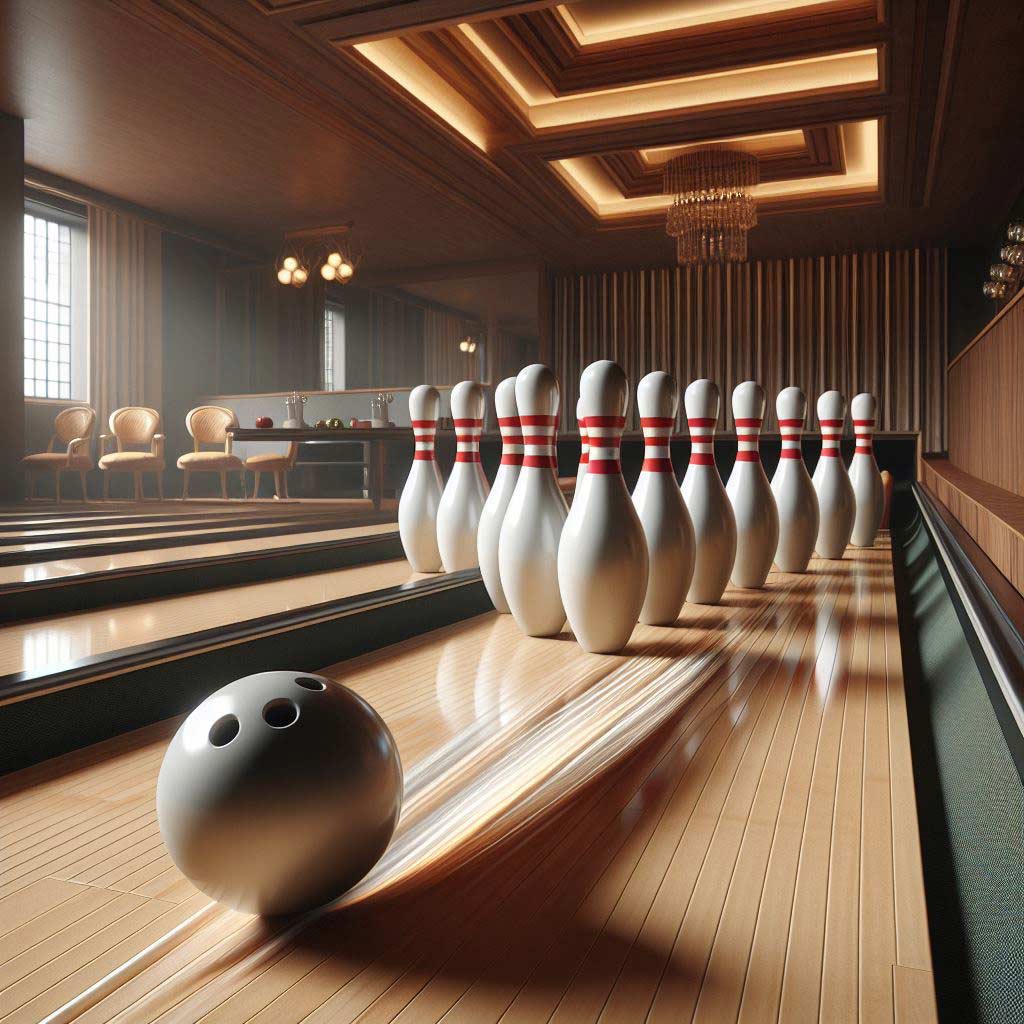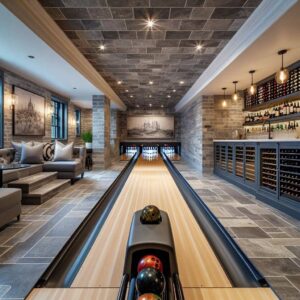At first glance, shuffleboard and bowling may seem like two completely different games. One is a leisurely tabletop activity, while the other is a classic bowling alley sport.
However, the world of sports and recreation is full of unexpected combinations, and one such hybrid is the intriguing game of shuffleboard bowling.
Shuffleboard bowling is a unique fusion of these two beloved pastimes, blending the sliding and targeting elements of shuffleboard with the rolling and knocking down of pins from bowling. This captivating hybrid game has been gaining traction in recent years, captivating both seasoned players and newcomers alike.
In this comprehensive guide, we’ll delve into the fascinating history of shuffleboard bowling, explore the equipment and gameplay, and uncover why this unique sport has captured the attention of leisure and competitive players around the world. Whether you’re a seasoned shuffleboard enthusiast or a bowling aficionado, you’re sure to find something to pique your interest in the world of shuffleboard bowling.
What is Shuffleboard Bowling?
Shuffleboard bowling, also known as bowling shuffleboard or shuffleboard skittles, is a variant of the classic game of shuffleboard that incorporates elements of ten-pin bowling.
In this hybrid sport, players use a bowling ball instead of the traditional shuffleboard puck, and the objective is to knock down a set of pins positioned at the end of the shuffleboard court or table.
The basic rules of shuffleboard bowling are as follows:
- Playing Surface: The game is played on a standard shuffleboard court or table, which is a long, rectangular surface with a smooth, waxed surface.
- Bowling Balls: Instead of the lightweight, disc-shaped pucks used in traditional shuffleboard, players use standard bowling balls to propel down the court.
- Pins: A set of bowling pins, typically 10 in number, are set up at the far end of the shuffleboard court, replacing the traditional scoring triangle.
- Scoring: Players take turns sliding or rolling the bowling ball down the court, attempting to knock down as many pins as possible. The scoring system is similar to traditional bowling, with points awarded based on the number of pins knocked down.
- Gameplay: Players alternate turns, with each player or team taking a set number of shots per round. The objective is to accumulate the highest score by knocking down the most pins over the course of the game.
While the overall gameplay of shuffleboard bowling shares similarities with both shuffleboard and bowling, the combination of these two beloved games creates a unique and engaging experience for players of all skill levels.
The History of Shuffleboard Bowling
The origins of shuffleboard bowling can be traced back to the 16th century, when the game of shuffleboard first emerged in Europe. The earliest known records of shuffleboard date back to the courts of English nobility, where the game was played as a form of leisure and social interaction.
As shuffleboard gained popularity, it eventually made its way to the American colonies in the 17th century. The game became a beloved pastime in taverns, hotels, and seaside resorts, where it was often played by both the upper and working classes.
Meanwhile, the sport of bowling, with its roots in ancient civilizations, had also been gaining traction in Europe and North America. Bowling alleys and lanes began popping up in cities and towns, offering a social and competitive outlet for players.
It wasn’t until the early 20th century that the concept of combining shuffleboard and bowling began to take shape. Some sources suggest that the idea for shuffleboard bowling emerged in the United States, as a novel way to blend the two popular games and create a new, unique form of recreation.
One of the earliest known instances of shuffleboard bowling being played dates back to the 1920s, when it was introduced at the Hotel del Coronado in Coronado, California. This seaside resort, known for its opulent accommodations and entertainment, became a hub for the burgeoning shuffleboard bowling phenomenon.
As the decades passed, shuffleboard bowling continued to evolve and spread to other parts of the country. Dedicated shuffleboard bowling facilities and tournaments began to emerge, catering to both casual players and competitive enthusiasts.
Today, shuffleboard bowling can be found in a variety of settings, from classic bowling alleys and family entertainment centers to upscale bars and lounges. The game has become a beloved pastime for those seeking a unique and engaging blend of two classic sports.
The Equipment and Setup
Shuffleboard bowling requires a specialized setup that combines elements from both the game of shuffleboard and the sport of bowling. Let’s take a closer look at the essential equipment and the typical layout of a shuffleboard bowling court or table.
The Shuffleboard Surface
At the heart of shuffleboard bowling is the shuffleboard table or court. These playing surfaces are typically long and narrow, measuring anywhere from 12 to 22 feet in length and 14 to 20 inches in width. The surface is made of a smooth, waxed material, such as maple or a synthetic composite, which allows the bowling balls to slide and glide effortlessly.
Bowling Balls and Pins
Instead of the lightweight, disc-shaped pucks used in traditional shuffleboard, shuffleboard bowling players use standard 10-pin bowling balls. These balls, typically ranging from 6 to 16 pounds in weight, are rolled or propelled down the shuffleboard surface.
At the opposite end of the shuffleboard court, a set of 10 bowling pins is set up in a traditional triangular formation, just as they would be in a bowling alley. These pins, made of wood or a durable synthetic material, serve as the targets that players aim to knock down with their bowling balls.
Scoring System
The scoring system in shuffleboard bowling is similar to that of traditional 10-pin bowling. Players earn points based on the number of pins they are able to knock down with each shot. A strike (knocking down all 10 pins with a single shot) is worth 10 points, while a spare (knocking down all 10 pins in two shots) is worth 10 points plus the number of pins knocked down on the next shot.
The total score for a game of shuffleboard bowling is calculated by adding up the points earned from each round or frame, just as in a standard bowling game.
Shuffleboard Bowling Layout
The typical shuffleboard bowling setup features a long, rectangular court or table with a smooth, waxed surface. At one end of the court, the 10 bowling pins are set up in a triangular formation, positioned a predetermined distance from the starting line.
Players take turns standing at the opposite end of the court, using the shuffleboard markings and boundaries to guide their bowling ball shots. The court may also feature scoring lines or other markings to help players gauge the distance and trajectory of their shots.
In some cases, shuffleboard bowling can be played on a modified or custom-built table that combines the shuffleboard surface with the bowling pin setup, creating a self-contained, all-in-one playing area.
By understanding the specialized equipment and layout of a shuffleboard bowling setup, players can better prepare themselves for the unique challenges and strategies involved in this captivating hybrid sport.
How to Play Shuffleboard Bowling
Now that you’re familiar with the equipment and setup of shuffleboard bowling, let’s dive into the details of how to play the game.
Basic Rules and Gameplay
The basic gameplay of shuffleboard bowling follows a similar structure to traditional 10-pin bowling, with a few key differences:
- Number of Players: Shuffleboard bowling can be played individually or in teams, with players taking turns shooting the bowling ball down the court.
- Shooting the Ball: Players use an underhand or sidearm motion to propel the bowling ball down the shuffleboard court, aiming to knock down as many pins as possible.
- Scoring: Points are awarded based on the number of pins knocked down, with a strike (knocking down all 10 pins) earning the highest score.
- Frames and Rounds: The game is typically played over a set number of frames or rounds, with each player or team taking their turns in a predetermined order.
- Variations: Some variations of shuffleboard bowling may include team play, handicaps, or different scoring systems to accommodate different skill levels and preferences.
Shooting Techniques
Mastering the art of shooting the bowling ball on a shuffleboard court is a crucial aspect of the game. Players can employ a variety of techniques to control the speed, trajectory, and spin of the ball, including:
- Underhand Roll: This is the most common shooting technique, where the player uses an underhand motion to roll the ball down the court.
- Sidearm Shoot: Some players prefer a sidearm shooting style, which can impart more spin and control on the ball’s trajectory.
- Backhand Shot: For more experienced players, a backhand shot can be used to create unique angles and spin on the ball.
- Curve Shots: By applying subtle spin or adjusting the angle of the release, players can create curved shots that can navigate around obstacles and pin formations.
Developing a consistent and accurate shooting technique is key to success in shuffleboard bowling, as it allows players to consistently knock down the pins and achieve high scores.
Strategies and Tactics
In addition to proficient ball-handling skills, effective strategies and tactics can give players an edge in shuffleboard bowling. Some common strategies include:
- Pin Positioning: Carefully considering the placement and arrangement of the pins can help players devise shot plans to maximize the number of pins knocked down.
- Spin and Angles: Utilizing spin and adjusting the angle of the shot can help players navigate around obstacles, set up spare opportunities, and create more favorable outcomes.
- Shot Placement: Positioning the bowling ball in strategic areas of the court, such as the center or near the edges, can set up players for better scoring opportunities.
- Anticipation and Adaptation: Closely observing the playing conditions, opponent’s strategies, and the development of the game can help players make adjustments and capitalize on opportunities as they arise.
By combining technical proficiency with strategic thinking, shuffleboard bowling players can elevate their game and consistently achieve high scores.
The Appeal and Popularity of Shuffleboard Bowling
Shuffleboard bowling’s unique blend of traditional shuffleboard and bowling has captured the attention of both casual players and competitive enthusiasts alike. Several factors contribute to the growing popularity of this hybrid sport:
- Social and Recreational Appeal: Shuffleboard bowling provides a fun and engaging social experience, allowing players to interact, compete, and bond over a shared activity. Its casual and approachable nature makes it an attractive option for social gatherings, team-building events, and friendly competitions.
- Accessibility and Inclusivity: Compared to traditional bowling, shuffleboard bowling is generally more accessible, as it requires less physical strength and mobility. This makes it an appealing option for players of all ages and skill levels, from young families to seniors, fostering a inclusive and welcoming environment.
- Unique and Engaging Gameplay: The blending of shuffleboard and bowling creates a novel and captivating gameplay experience, offering players a fresh challenge and a break from the monotony of traditional sports. The strategic elements, combined with the tactile satisfaction of knocking down pins, contribute to the game’s appeal.
- Hybrid Sport Trend: In recent years, the growing popularity of hybrid sports, which combine elements of different disciplines, has contributed to the rise in interest for shuffleboard bowling. Consumers are drawn to the novelty and the opportunity to experience a unique fusion of familiar activities.
- Competitive Opportunities: While shuffleboard bowling is primarily a recreational pursuit, the sport has also seen the emergence of competitive leagues, tournaments, and professional organizations. This has expanded the game’s appeal to players seeking a more structured competitive environment.
- Versatile Venue Options: Shuffleboard bowling can be played in a variety of settings, from classic bowling alleys and family entertainment centers to upscale bars, lounges, and specialty shuffleboard facilities. This versatility allows the sport to cater to diverse audiences and settings.
As the popularity of shuffleboard bowling continues to grow, it’s likely that we’ll see even more venues, events, and innovations in the years to come, further solidifying its place as a unique and engaging hybrid sport.
Where to Play Shuffleboard Bowling
Shuffleboard bowling can be enjoyed in a variety of settings across the United States and beyond. Whether you’re looking for a casual outing or a more competitive experience, there are plenty of options available to satisfy your shuffleboard bowling cravings.
Dedicated Shuffleboard Bowling Facilities
In recent years, there has been a rise in dedicated shuffleboard bowling facilities and entertainment centers catering specifically to this hybrid sport. These specialized venues often feature high-quality shuffleboard courts or tables, comfortable seating areas, and sometimes even additional amenities like bars, restaurants, and lounge spaces.
One notable example is the Shuffleboard Social in St. Petersburg, Florida, which boasts multiple regulation-size shuffleboard courts and regularly hosts shuffleboard bowling tournaments and leagues. Similarly, the Shuffleboard Club in Las Vegas, Nevada, offers a premier shuffleboard bowling experience in a stylish, modern setting.
Bowling Alleys and Family Entertainment Centers
Many traditional bowling alleys and family entertainment centers have embraced the concept of shuffleboard bowling, integrating the hybrid sport into their offerings. These venues often have designated shuffleboard bowling lanes or tables, allowing visitors to experience the unique blend of the two classic games.
Locations like Pinstripes, with multiple locations across the United States, have successfully incorporated shuffleboard bowling into their diverse array of gaming and dining options, catering to families, groups, and corporate events.
Bars, Lounges, and Resorts
The social and recreational nature of shuffleboard bowling has also made it a popular addition to bars, lounges, and even high-end resorts. These venues recognize the appeal of the game as a unique form of entertainment and a way to attract patrons looking for a distinctive and engaging activity.
For example, the Hotel del Coronado in Coronado, California, where shuffleboard bowling was first introduced in the 1920s, still maintains shuffleboard bowling courts for guests to enjoy.
Similarly, upscale bars and lounges in cities like New York, Chicago, and Los Angeles have incorporated shuffleboard bowling into their offerings, creating a sophisticated and elevated experience for their patrons.
Whether you’re seeking a dedicated shuffleboard bowling facility, a bowling alley with integrated shuffleboard, or a unique bar or resort experience, there are plenty of options available for players to indulge in the fun and challenges of this fascinating hybrid sport.
Conclusion
Shuffleboard bowling is a captivating blend of two classic games, offering players a unique and engaging recreational experience. From its historical origins in Europe and the United States to its growing popularity in modern times, this hybrid sport has captured the attention of leisure enthusiasts and competitive players alike.
The specialized equipment, strategic gameplay, and social appeal of shuffleboard bowling make it a compelling choice for those seeking a fresh and exciting way to enjoy leisure time.
As the popularity of hybrid sports continues to rise, it’s likely that we’ll see even more innovations and advancements in the world of shuffleboard bowling.
Whether you’re a seasoned shuffleboard enthusiast, a bowling aficionado, or simply someone looking for a new and unique activity to try, shuffleboard bowling is undoubtedly worth exploring. So gather your friends, lace up your bowling shoes, and get ready to experience the unexpected thrill of this one-of-a-kind hybrid sport.





